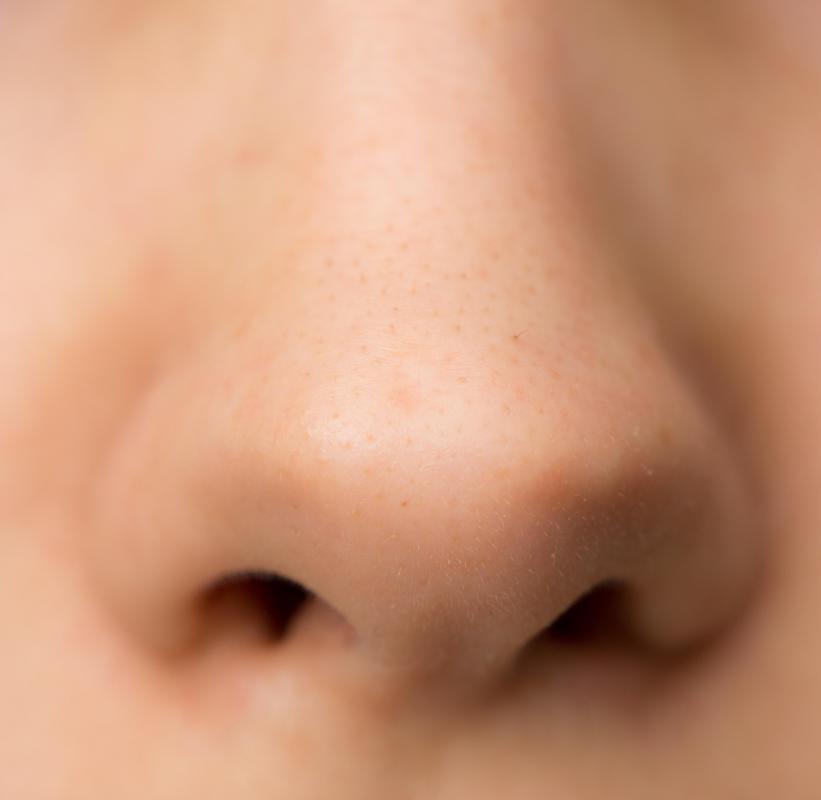At TheHealthBoard, we're committed to delivering accurate, trustworthy information. Our expert-authored content is rigorously fact-checked and sourced from credible authorities. Discover how we uphold the highest standards in providing you with reliable knowledge.
What is the Olfactory Bulb?
The olfactory bulb is a structure found in the brains of vertebrates that processes information about odors, and is a key part of the neural system responsible for the sense of smell. Cells located in the nose that process odor input send signals directly to the olfactory bulb. It then serves as a pathway for that input to travel to different locations in the rest of the brain.
The olfactory bulb is a part of the limbic system. Within the brain, the bulb is located in the forebrain, though in humans it sits at the bottom while in other vertebrates it sits at the very front. A bony structure called the cribiform plate cradles and protects it, and separates it from the nasal cavity. It is divided into two sections, the main section and the accessory section.

When an odor enters the nasal cavity, it interacts with the millions of olfactory receptors located there. Those receptors send signals along their axons, which are the parts of the cells that carry information away from them. The axons extend through the cribiform plate and directly into the main olfactory bulb, and actually make up a portion of the structure. They form spherical clusters known as glomeruli, which in turn interact with neurons known as mitral cells. The mitral cells take the signals the rest of the way to the olfactory cortex; this is where awareness and identification of specific odors takes place.

The process is similar for the accessory olfactory bulb, except the input being processed is pheremones instead of odors. A separate sensory organ located in the nose, the vomeronasal organ, detects pheremones and passes the signal via axons to the glomeruli in the accessory bulb. There, mitral cells also pick up the information, but instead of sending it to the olfactory cortex, they send it to the amygdala and hypothalamus.

In animals with a strong sense of smell, the olfactory bulb is relatively large. Animals with less olfactory capacity, including humans, tend to have a smaller bulb in proportion to their brain. Research has shown that this part of the brain changes in size over the course of human adulthood. There is also a correlation between the amount of input being processed by the bulb and how large it is. For example, someone who has lost his or her sense of smell due to injury or disease might have a smaller olfactory area than average.
AS FEATURED ON:
AS FEATURED ON:













Discussion Comments
@uniqturtl - from what I've read, about 2 million people have anosmia, or lack of smell but I don't know if that means that they have no sense of smell due to illness, disease or injury or if they were born without the function of the olfactory bulb in their brain or possibly, without an olfactory bulb at all.
I understand that due to disease that the olfactory bulb can shrink, thus reducing the sense of smell. I wonder, though, how many people are born without their sense of smell?
@belle1984 – When the olfactory bulb is damaged, a variety of dysfunctions can arise depending upon the extent of the damage. These dysfunctions can cause severe changes in a person’s sense of food flavors and can prevent a person from assessing environmental dangers (such as foul smells which may signal chemical leaks or airborne pollutants that could prove fatal).
Despite the relatively protected location of the olfactory bulb in the human brain (which is on the bottom of the brain), many common ailments can effect the olfactory bulb, such as upper-respiratory tract infections, head trauma, and nasal or sinus diseases. These causes produce a viral or bacterial-induced loss of smell, though it is unclear exactly how such occurs.
What happens when the olfactory bulb is damaged?
Post your comments